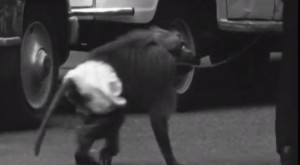“From a distant gaze …” (1964) directed by Jean Ravel, picture Pierre Lhomme & Chris Marker, words by Louis Aragon, narrated by Jean Negroni, music by Michel Legrand.
Describe a few things that intrigue you – it might be shot construction, camera work, editing, overall structure, thematic concerns etc. Describe the camera work and why you think it has been shot that way.
“From a distant gaze…” (1964, Jean Ravel) has been shot in a way to get the viewer right amongst the action of the shot, so they can feel the movement as much as see it.

 The framing of shots is captivating as it only allows you to see a certain part of things at a certain time before it shows you something else, for example when the shot is following the man with the ladders, as he walks further along away from the camera the shot moves down to show a monkey on a leash. Therefore the figure who was just the man with the ladders then becomes the man with ladders and a monkey. Through this technique, the shots act as a constant discovery of space.
The framing of shots is captivating as it only allows you to see a certain part of things at a certain time before it shows you something else, for example when the shot is following the man with the ladders, as he walks further along away from the camera the shot moves down to show a monkey on a leash. Therefore the figure who was just the man with the ladders then becomes the man with ladders and a monkey. Through this technique, the shots act as a constant discovery of space.
The space within the frame also contested, with shots being tight within the scenes, zoomed in on certain parts of the movement sometimes making the viewer feeling claustrophobic with their relationship with what’s on screen. For example, in the beginning of the clip we see the people walking with the occasional car driving past taking over the shot in front of them. This choice to shoot from a far and allow the cars to disrupt the shot at different moments, juxtaposes the organic movement of people as if it’s overpowered by mechanical movement, perhaps suggesting the mechanical takeover of movement on people.
In terms of camera work, there are moments when you can truly appreciate the fearlessness in following a shot for a long time, sitting and tracking the movement instead of moving on.  This can be seen when the little boy bounces the basketball along the street, people walk past him but in us following him, he is isolated to his own world where bouncing and being a child is the only priority. Furthermore, editing follows the flow of movement throughout the piece, only getting people’s legs at the start to disassociate them from the body, but correlating it with other people’s legs.
This can be seen when the little boy bounces the basketball along the street, people walk past him but in us following him, he is isolated to his own world where bouncing and being a child is the only priority. Furthermore, editing follows the flow of movement throughout the piece, only getting people’s legs at the start to disassociate them from the body, but correlating it with other people’s legs.
This short clip is also very inspiring for our documentary about Larping, with many of the shots being on field in the action and framing things close up, to be able to re-interpret this kind of edit where movement is sustained and explored would be an achievement to strive towards in our piece.